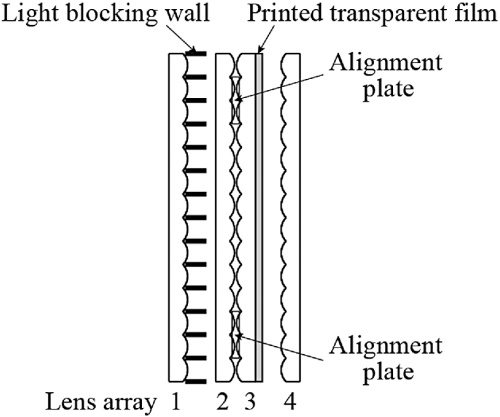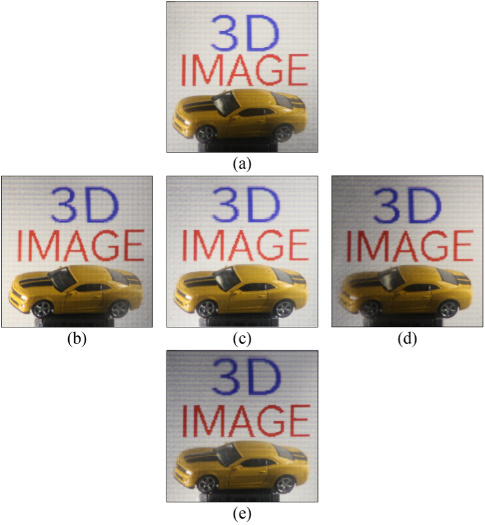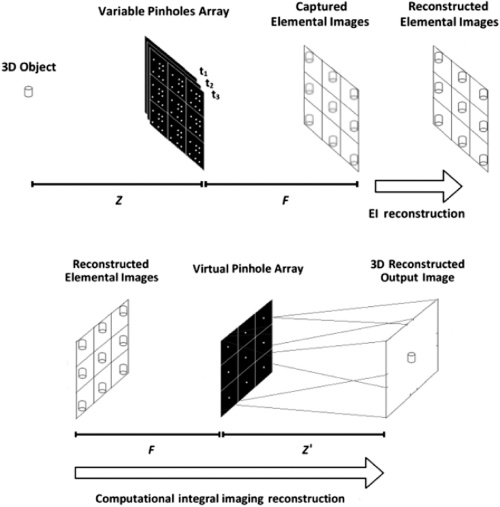一、本期重点:
1.基于集成成像的平面透视三维显示(Flat-panel see-through three-dimensional display based on integral imaging) 【Optics Letters】
doi:10.1364/OL.40.001873
published:2015.4.14
内容介绍:
文章叙述了一种基于集成成像的平面透视三维显示方法。结构包括多透镜陈列、透明平面显示器和阻光墙(light-blocking wall)。通过多透镜阵列光线在显示器前被重构,阻光墙提供了透视功能。多透镜阵列与透明平板显示器提供了全视差三维图像,叠加在背景之前。
图一是实验装置示意图,光阻墙可以阻止多背景图像的产生。图二展示了图像叠加在真实背景之前的效果。

图一 实验装置示意图

图二 图像叠加在真实背景之前的效果图(分别从不同视角进行拍摄)
2.使用可变、时分针孔阵列的无透镜集成三维显示(Lensless three-dimensional integral imaging using variable and time multiplexed pinhole array)【Optics Letters】
doi:10.1364/OL.40.001814
published:2015.4.13
内容介绍:
文章提出了一种多元编码孔径(multivariable coded aperture)无透镜集成三维显示系统。装置主要基于时分的可变针孔阵列。系统可以提供更高的三维图像分辨率、更高的图像亮度、更好的信噪比。系统保留了针孔光学在分辨率、长曝光时间上的优势。系统有更大的聚焦深度、更简单的结构和较低的成本。
图一是系统原理图。图二展示了两个不同深度信息物体的重建效果。

图一 系统原理图

图二 不同深度信息物体的重建效果
二、简讯:
doi:10.1364/OE.23.011092
published:2015.4.21
Abstract:
Ghost imaging has rapidly developed for about two decades and attracted wide attention from different research fields. However, the practical applications of ghost imaging are still largely limited, by its low reconstruction quality and large required measurements. Inspired by the fact that the natural image patches usually exhibit simple structures, and these structures share common primitives, we propose a patch-primitive driven reconstruction approach to raise the quality of ghost imaging. Specifically, we resort to a statistical learning strategy by representing each image patch with sparse coefficients upon an over-complete dictionary. The dictionary is composed of various primitives learned from a large number of image patches from a natural image database. By introducing a linear mapping between non-overlapping image patches and the whole image, we incorporate the above local prior into the convex optimization framework of compressive ghost imaging. Experiments demonstrate that our method could obtain better reconstruction from the same amount of measurements, and thus reduce the number of requisite measurements for achieving satisfying imaging quality.
2.有限视角重构的微分像差计算层析成像(Limited view reconstruction for differential phase-contrast computed tomography)
doi:10.1364/OE.23.009717
published:2015.4.7
Abstract:
This paper describes an algebraic reconstruction algorithm that uses total variation (TV) regularization for differential phase contrast computed tomography (DPC-CT) using a limited number of views. In order to overcome over-flattening inherent in TV regularization, a two-step reconstruction process is used: we first reconstruct tomographic images of gradient refractive index from differential projections with TV regularization; these images are then used to compute tomographic images of refractive index by solving the Poisson equation. We incorporate TV regularization in the reconstruction process because the distribution of gradient refractive index is much more flattened than the refractive index. Simulations of the proposed method demonstrate that it can achieve satisfactory image quality from a much smaller number of projections than is required by the Nyquist sampling theorem. We experimentally prove the feasibility of the proposed method using dark field imaging optics at PF-14C beamline at the Photon Factory, KEK. The differential phase contrast projection data was experimentally acquired from a biological sample and DPC-CT images were reconstructed. We show that far fewer projections are needed when the proposed algorithm is used.
doi:10.1364/OE.23.009696
published:2015.4.7
Abstract:
We propose a generalized framework for quantitatively acquiring multidimensional complex objects based on single-shot phase imaging with a coded aperture (SPICA). In multidimensional SPICA, a propagating field from a multidimensional complex object is sieved by a coded aperture, the sieved field is modulated by an optical element, which is called coding optics, and then the resultant field is captured by a monochrome image sensor. The original complex field is reconstructed from the single captured intensity image by a phase retrieval algorithm with a support constraint of the coded aperture and a sparsity-based reconstruction algorithm based on compressive sensing. We also present theoretical conditions for the proposed method. As a demonstration, we numerically verified an application of this generalized framework for single-shot acquisition of depth-variant multispectral objects.
doi:10.1364/OE.23.009397
published:2015.4.3
Abstract:
We present a thin-film sensor that optically measures the Radon transform of an image focussed onto it. Measuring and classifying directly in Radon space, rather than in image space, is fast and yields robust and high classification rates. We explain how the number of integral measurements required for a given classification task can be reduced by several orders of magnitude. Our experiments achieve classification rates of 98%–99% for complex hand gesture and motion detection tasks with as few as 10 photosensors. Our findings have the potential to stimulate further research towards a new generation of application-oriented classification sensors for use in areas such as biometry, security, diagnostics, surface inspection, and human-computer interfaces.
供稿:王恒







